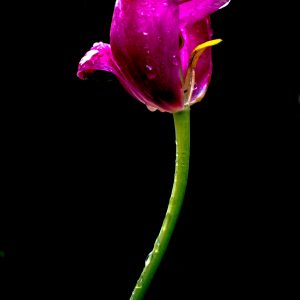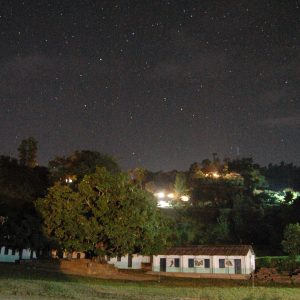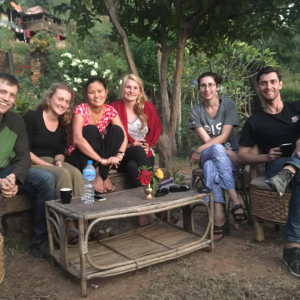I’m back! Just when you thought you could get rid of me, I’m sneaking another guest blog post in. That’s right, Katie’s dad here to rob you of a few more precious minutes of your time. Think of me as a bad rash—I may go away for a while, but I always return.
When you plan a trip to an exotic place, your first stop should be to your doctor. In our case, all travel-related issues are handled by a group called Passport Health. When you contact them, they will ask where you’re going, what you plan to do, and schedule an appointment. Arriving for your appointment, they will have a nice bound booklet prepared for trip. It even has your name on it, making you feel special and important. The book contains tons of helpful information: emergency contacts, locations of hospitals, how to reach the embassy, and many other things that will help you if you get into trouble. That is, if you actually remember to bring it along. Sitting on your desk 10,000 miles away, its usefulness drops to somewhere between pocket lint and gum stuck to your shoe.
The nurses at Passport Health are very nice. They will pleasantly explain every possible disease you can come in contact with, using color-coded maps to show you where each of these diseases are. And the booklet they just handed you predicts, with 98% certainty, that you’ll contract at least one life-threatening illness while you’re away, probably several, and that your best chance for survival is to never leave your hotel room.
“Surely it can’t be that bad,” I said as I leafed through the book.
Removing her glasses so she could give me the full eye stare-down, she replied “It is that bad. And don’t call me Shirley.”
Ok, so maybe I’m exaggerating—a little. You do have to get some shots. Most importantly, you need your prescription for traveler’s diarrhea and a first aid kit.
When I left for Nepal, I was armed with my hepatitis A and B shots, typhoid shot, tetanus booster, traveler’s diarrhea pills (both prescription and Imodium—trust me, you can’t have too much of that stuff), and a basic first aid kit. I also took malaria pills, even though there’s debate about whether malaria still exists in Nepal. With that, you’re prepared for anything…unless you want to eat or drink (or take a shower) while you’re there.
Water is important. I read that on the Internet, so it must be true. The problem is, in places like Nepal, you can’t drink the water. You can’t brush your teeth with it. And you’re warned about getting it in your eyes and mouth while showering. Ever try to wash your hair without getting water on your face? I’m forced to stand and arch backwards in sort of a limbo move, keeping my head at an angle so water runs off the back of my head, all the while praying that I don’t overextend and fall backwards. Most of the time my arms are flailing as I try to keep my balance. I must be quite a site.
Drinking bottled water isn’t a question—it’s mandatory. Hotels are so accustomed to it most have bottles of water in the room which they resupply every day. Need more? Just ask—I’ve never been charged for more bottles. Generally, sodas and beer are safe (yeah!), but I’ll warn you about straws. I’ve been leery of them since the Great Straw Incident of 2013 (and don’t get me started about the coffee spoon issue).
What happened in 2013? Katie, Liz, and I were in Leh, India. It’s a beautiful place and I highly recommend going. While we were walking around, I came across a restaurant that was washing its dirty dishes outside the front door…with a bucket on the ground…using dirty water (the same water was used for both washing and rinsing. I guess it saves time.) Anyway, among the piles of dishes, there were a bunch of “previously enjoyed” straws. This restaurant reused them. I have been very reluctant to use unwrapped straws since. More on straws later, and how I inadvertently pranked a Japanese tourist.
Now onto food. When I arrived in Nepal, Katie wanted to immerse me in the culture immediately. So, where did we go? To Fire and Ice Pizza, of course! What better way to get into the swing of things than to sit down with all the other tourists and Expats. Kudos to Katie for the choice, though, because it was really good pizza. My only concern was that we ordered half with “spicy meat sauce.” I didn’t ask, nor do I want to know, what meat was used. It tasted good. Leave it at that.
At this point you’re probably dying to know what was on the other half of the pizza. Mushrooms. Only in Nepal they call it fungi. To make sure the server understood what I wanted, I pointed to it and he replied “fun-gee pizza.” Fun-gee—my new favorite word! It’s impossible to say “fun-gee” five times in a row without smiling. Try it: fun-gee, fun-gee, fun-gee, fun-gee, fun-gee. See? You’re smiling, I just know it.
It turns out that I ate fun-gee pizza a lot in Nepal. I did it for several reasons. First, it was all cooked, and that’s a number one requirement. Unless you’re very sure of the source, don’t eat anything that’s not cooked. Second, it was meatless. Don’t get me wrong – I love meat. The more I get the happier I am. Especially bacon (salty goodness of the gods). But in Nepal, as in other similar countries, the word meat can have a lot of leeway. You really have no idea what parts of what animals you’re consuming. And they don’t believe in refrigeration much, so raw meat and fish will hang out for hours—literally, the meat sits outdoors. Great for flies…not so much for me. The third reason? Most of the time it was really good pizza!
I did eat other things. I had Mongolian noodle soup, which is very filling. I had vegetable Mo-Mo’s (very good dumpling-like items), Mongolian chicken something or another, and a few other things. I even had chicken fajitas, but the cheese they used was Yak cheese. Yak cheese on a Mexican dish is a culture clash I could have done without.
I also ate dal-bhat with Katie’s host family. Dal-bhat is white rice with lentils. Very, very filling, and not bad once in a while, especially when mixed in with a few vegetables. Katie and her host family eat this twice a day, every day. It’s just what they do. I like to eat the same foods a lot, but a 2x daily dose of dal-bhat is a bit much. Now if it were fun-gee pizza…
Oh, about that Japanese tourist. On our last day, we went to a great coffee shop called Himalayan Java. It’s another place filled with foreigners, and it’s a lot like sitting in a Starbucks (boy, did it feel great. A little slice of home right in Nepal). On the menu, they explain that the use filtered water for everything, so I summoned up my courage and ordered an iced coffee (that’s right, with actual ice made from real water). The server arrived after a few minutes with my coffee, and plunked down into the glass was—gasp—an unwrapped straw! Oh No! It’s déjà vu all over again. I really only had a few options. I could refuse to drink it, I could ask for one without a straw (although I suspect that they would just remove the straw and hand it back to me), or I could suck it up (literally) and drink it. I chose a fourth option. Even though the damage was done, I just removed the straw and placed it on the table, trying to block out that it was ever in my drink to begin with.
Katie and I were sitting across from each other chatting away, but as Himalayan Java got crowded, I moved to sit next to her, leaving the straw behind. A Japanese woman and her friend sat down and for some unknown reason, she picked up my straw. I watched her expression as she went from curious, to concerned, then straight to mortified as she realized what she had done, quickly dropping the straw and desperately searching something to wipe her hands with. I tried to explain to he why the straw was there, but my Japanese is about as good as my Nepali. For a while I thought I may have sparked some sort of international incident, but nothing was on CNN, so I guess it worked out.
Next time I go to Nepal, I’ll bring my own straws.


